Protecting Your Contact Center Agents’ Emotional Well-Being
Every workplace has its pros and cons, but contact center agents have one of the toughest jobs out there. They’re protecting and building your company’s brand — no matter what they have to deal with from customers.
Just like agents are protecting your company, contact center leaders and managers need to protect them and their mental health. Building a supportive work climate is the first step.

Signs And Effects Of Poor Agent Emotional Well-Being In Your Contact Center
Working with customers requires a lot of emotional labor from your customer service center agents — even if customers are happy. The emotional intelligence required to keep a pleasant tone, remember all steps in your processes, hit all the requirements for your KPIs, and deliver empathy all at the same time can be tremendous.
Burnout
Burnout is at the heart of poor emotional well-being in a contact center. Working with customers day in and day out can be draining, and customer service reps who struggle with the emotional demands of customer service can quickly show signs of being overwhelmed.
Signs of contact center burnout to look for include new or increased:
- Irritability or cynicism
- Disengagement
- Isolation from colleagues
- Absenteeism
- Decreased productivity or performance
These signs should be addressed immediately when you notice them. Not only are they bad for business, but they’re also bad for customer support center employees themselves. The Mayo Clinic details the negative impact burnout has on employees’ health, including:
- Excessive stress
- Fatigue
- Insomnia
- Sadness, anger, or irritability
- Alcohol or substance misuse
- Heart disease
- High blood pressure
- Type 2 diabetes
- Vulnerability to illnesses
Related Article: How Contact Center Agent Burnout Decreases Productivity (And What You Can Do About It)
Interaction Avoidance
You might notice burnout in the form of interaction avoidance — when agents deliberately get around engaging in customer service interactions. While sometimes interaction avoidance truly is an agent trying to get out of work, in many other instances, it’s a way to cope with feeling overwhelmed by customer mistreatment or aggression. It also could be a sign that the agents are overworked.
A big contributor to this burnout and the resulting avoidance is customer behavior. Ticket volumes and customer feedback are way up in the last few years. This makes working with customers more difficult than ever — and staffing according to volumes across channels is critical.
According to the 2023 Customer Rage Study by CCMC and Arizona State University, 74% of respondents reported experiencing a problem with a company’s product or service, up from 66% in 2020 and 56% in 2017. To get a resolution for their problems, 79% of customers complained to the company at fault, an increase from 72% in 2020.
The study also revealed that customers are turning to digital channels to complain more often than phone calls, with 32% of customers surveyed sharing their complaints on social media.
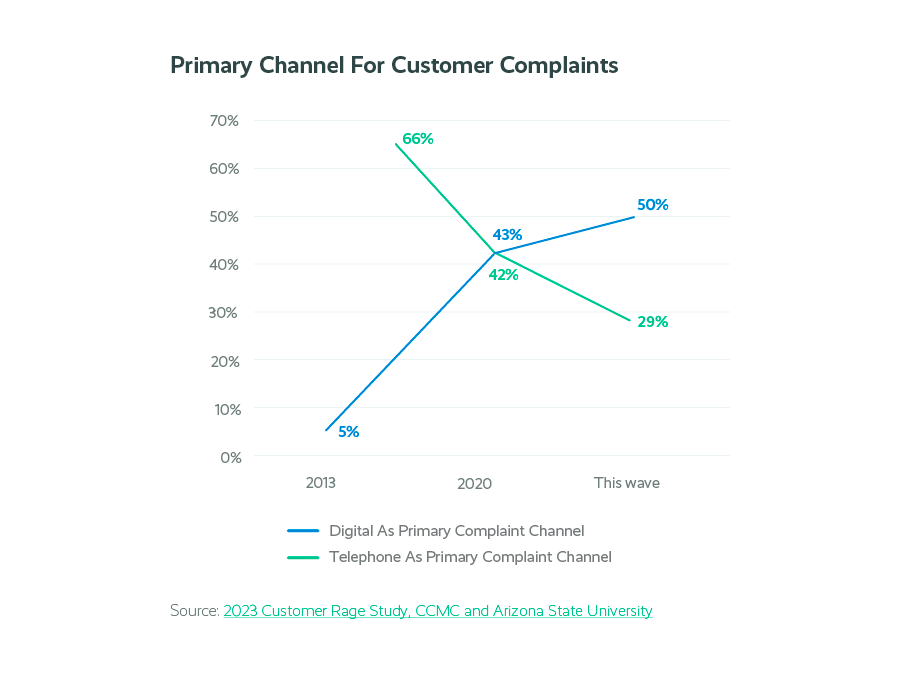
Quiet Quitting
Burnout can also lead agents to engage in “quiet quitting,” in which they perform their duties just well enough to fulfill their job requirements — nothing less and nothing more. They’re not avoiding interactions, but they’re not going the extra mile either, usually because they’ve become so disengaged.
Agents simply going through the motions is the last thing you need with customer service expectations at an all-time high. Gartner found that disengaged agents actually make getting support harder for your customers by not resolving issues quickly, by forcing them to repeat information, and by failing to help them resolve their issues in fewer steps.
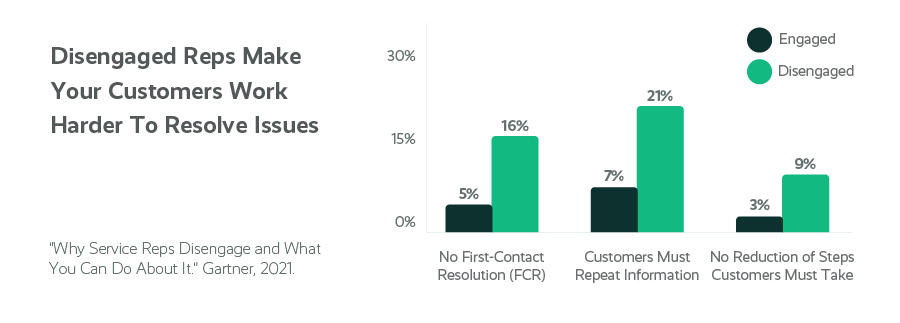
Attrition
Turnover has long been an issue in contact centers. In 2022, the average agent turnover rate at all contact centers was 24% and climbed as high as 30% for large customer service centers.
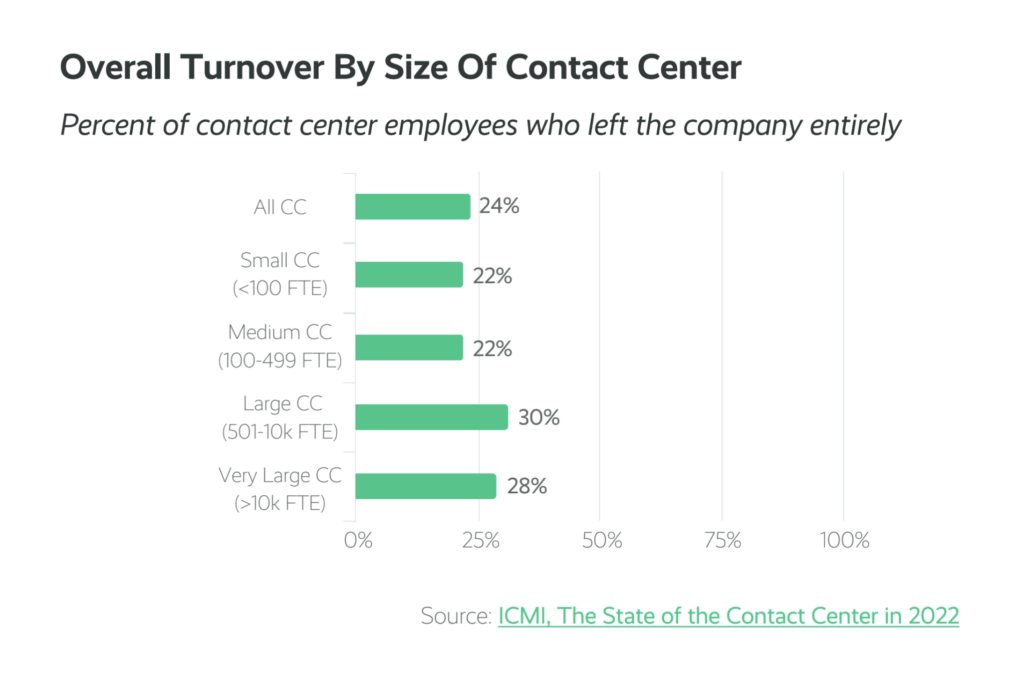
Disengaged agents are far more likely to leave — 84% more likely, according to Gartner’s study. The research showed that the two biggest drivers of disengagement were lacking clarity in their role and lacking support for their well-being.
Agents were 90% more likely to disengage if they didn’t understand how their role contributed to the company goals and what they were supposed to prioritize and work toward. They were 66% more likely to disengage if they didn’t feel their development, health, and comfort were supported.
Replacing agents lost to attrition is costly — averaging more than $14,000 per agent. To keep turnover under control, you have to make sure your managers are trained to keep engagement up and morale high.
Related Article: 7 Smart Ways to Reduce Call Center Turnover Forever
The Role Of A Manager In Agent Well-Being
Few things have a bigger impact on your agents’ emotional well-being than how they’re managed. According to Gallup, 70% of the variance in team engagement is determined by the team’s manager.
The potential causes of employee burnout are no surprise, but managers play a big role in keeping them at bay. Managers can have an impact — positive or negative — on an agent’s:
- Lack of control over their schedule, assignments, and workload.
- Unclear job expectations, especially around how much autonomy they have to make decisions and what the goals for their position are.
- Dysfunctional workplace dynamics, such as an office bully or a lack of engagement from peers.
- Extremes of activity, causing boredom or fatigue.
- Lack of social support at work. Years of Gallup studies have shown the positive impact of having a close friend at work on engagement and performance.
- Work-life imbalance. Too much work and not enough time with family and friends can have a significant impact on burnout.
But too many workplaces don’t focus on developing managers’ ability to support agents when they need it. A 2022 report by Mental Health America showed that in some organizations, as few as 3% of employees felt the business worked to train managers to be supportive of mental health concerns.
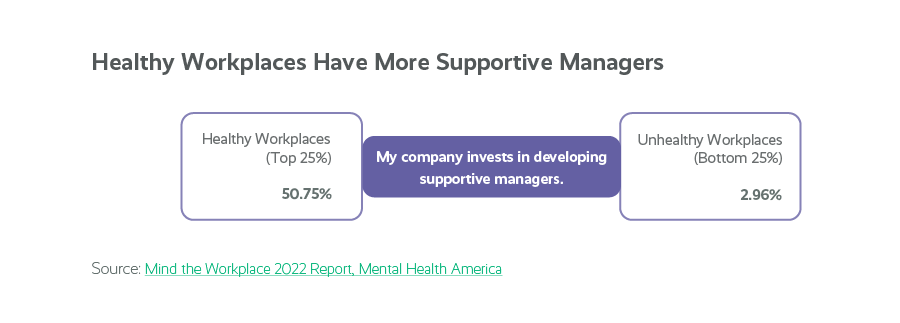
Related Article: 7 Ways to Drive Cultural Change that Boosts Agent Morale
Training Managers To Support Agents
Without well-trained, empathetic managers in place, your agent experience is bound to suffer, eventually leading to costly turnover. Gallup reports that low-effort managers engaging in “quiet firing” is a big issue. Quiet firing happens when managers don’t take an active role in employee engagement, support, and development, effectively pushing employees out the door.
In service centers, the source of managers’ lack of connection with agents often stems from a lack of training. A study by ICMI showed that areas like team-building and agent motivation weren’t covered in supervisor training as often as topics like quality and performance.
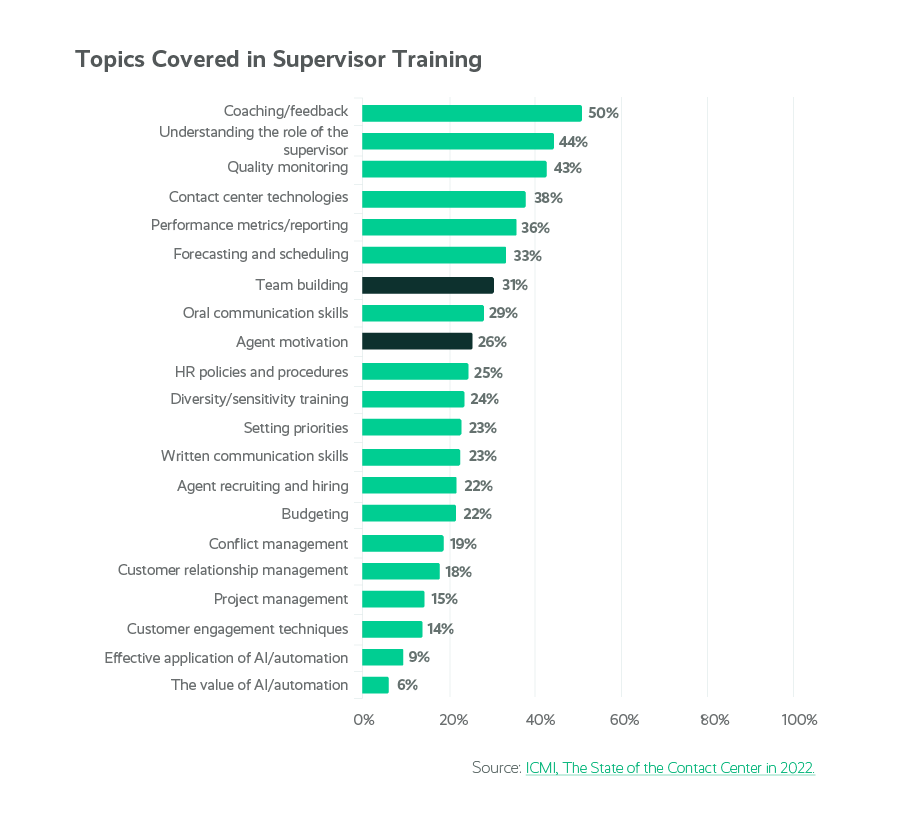
Adjusting managers’ training to focus on areas meant to engage and develop employees can go a long way toward building positive relationships that protect your agents’ emotional and mental well-being — and, in turn, prevent attrition.
It’s also important that contact center executives foster an environment where engaging and developing employees is a focus. Many managers may feel that they don’t have the flexibility to do this because it’s not important in higher levels of the organization. That culture starts at the top.
How Managers Communicate With Agents
Your managers’ communication style and abilities can help your customer service agents’ sense of well-being and engagement — or damage them.
How a manager gives feedback is one of the most important aspects of their communication. Most managers think they’re pretty good at it — 65% of managers in a Gallup study agreed or strongly agreed with the idea that they’re effective at delivering feedback. The trouble is that Gallup also found only 21% of employees felt they had received recent meaningful feedback. Only 26% feel the feedback they do get helps them do better work.
How feedback is framed has a tremendous effect on employee engagement. Gallup also found that employees who received negative feedback were far less likely to be engaged — they reported that it left them with negative emotions, including feeling criticized, demotivated, disappointed, or depressed.
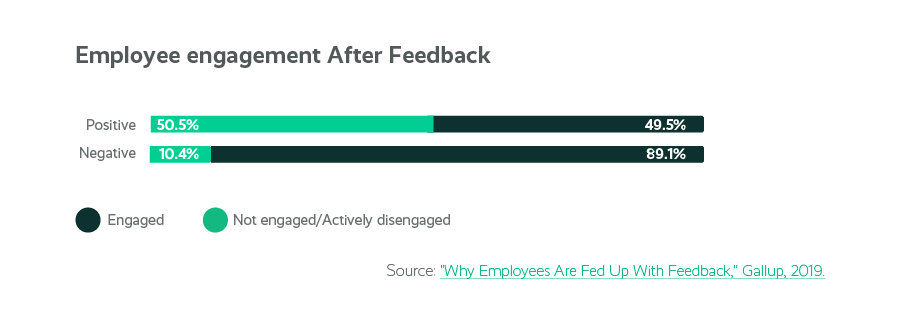
That’s not to say that all feedback should be positive. Agents need to hear when their performance could use some help. But the gap between how managers view feedback and how employees see it simply isn’t good for agent morale and mindset.
To keep engagement up, feedback should be focused on coaching rather than micromanaging. It should be:
- Objective, not based on personal preferences or viewpoints
- Focused on improvement, not punishment or scolding
- Frequent, not saved for annual reviews
Vague or infrequent feedback doesn’t help agents improve their customer experience skills and only serves to damage their relationship with their manager and the company. An ICMI report showed that most agents are evaluated quarterly, with just 27% receiving weekly feedback.
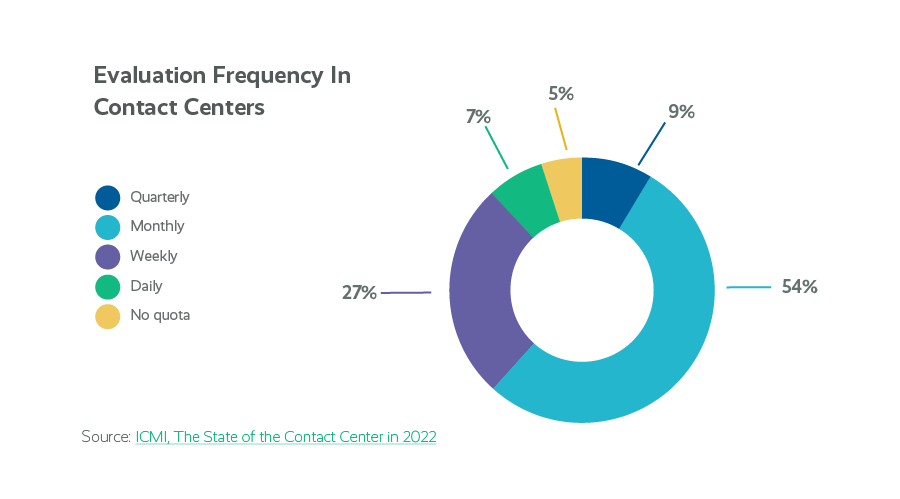
Give your contact center managers a goal of providing weekly feedback so agents know when they’re on the right track — and when they aren’t. Remember that understanding their role and goals was the most important factor in agent engagement. Agents can’t operate without that clarity, and frequent feedback is a way to make sure they get it.
A coaching solution that automatically delivers feedback on how to improve can be very effective. Automation has the added benefit of creating more time for personal engagement during feedback sessions. This helps your managers make their one-on-ones with agents about connecting and can help them notice signs of burnout and distress sooner.
It’s also important to understand the best way to coach each team member. Not everyone learns and absorbs feedback the same way, so having that conversation and getting to know each agent can be helpful in moving the performance needle.

The Role Of Customers In Agents’ Emotional State
As we’ve discussed, negative behavior from customers can affect how agents do their jobs and can sometimes cause them to avoid interactions to get a break from the stress.
But a new problem is emerging. Gartner predicts that by 2026, 75% of customers who contact customer service and support organizations will do it because they’re lonely, not because they need customer service.
Whether interactions occur by phone or chat, this increased outreach is likely to have a wide-ranging impact on agents’ emotional well-being. Dealing with customers in this mental state will be as draining as handling customers who are angry, creating more opportunities for mental burnout.
Handling lonely customers will require high emotional intelligence on the part of agents, potentially causing attrition. Gartner also predicted that by 2024, this emotional effort will be the top reason customer service reps leave the service center.
From a contact center leader’s perspective, you can protect agents’ emotional and mental well-being in these situations by using your customer sentiment analysis solution to monitor for language common to customers with high emotional demands. You can then use this data to train agents to identify a lonely customer and handle them accordingly.
Related Article: Responding with Empathy: 20 Ways to Show Stressed Out Customers You Care
The Role Of Contact Center Technology In Agents’ Emotional Well-Being
Today’s contact center technology can take a lot of manual tasks and time-consuming procedures off leaders’ and managers’ plates. With more time to invest in agent support, they can better connect and communicate with agents to keep engagement and motivation high.
Monitor Performance To Spot Burnout
Remember that a key sign of agent burnout is decreased productivity and performance. That’s why, when managers see an employee struggling to deliver the right customer experience, they should take an empathetic approach to discover what might be wrong under the surface.
Examining these key performance indicators (KPIs) to look for clues that an agent is struggling emotionally:
- Average Handle Time: An agent who isn’t meeting your benchmarks for interaction handle times could be struggling with disinterest in their work. Recall that according to Gartner, disengaged agents make interactions harder for the customer, which is likely to show up as longer handle times. Long handle times could also indicate that the agent isn’t disengaged but rather too engaged — investing too much emotional labor in customers’ issues.
On the other hand, short handle times might indicate an agent is rushing customers out of interactions. Look for extremes in time spent with customers to spot potential contact center burnout.
- Customer Satisfaction: An agent who is receiving poor customer service ratings after interactions also might be burned out with the emotional demands of their work. Examine customer sentiment in your feedback to look for language that indicates frustration or lack of engagement from the agent.
- Agent Productivity: Monitoring agent productivity can also help you identify when agents are burned out. Agents who aren’t meeting your KPI benchmarks for how many interactions they handle in a shift might be avoiding interactions or too distracted by emotional overwhelm. In either case, it’s important to dig into why an agent isn’t handling as many interactions as they are expected to so you can give them the support they need.
A performance management solution with a configurable dashboard will help you keep a close eye on the metrics that reveal potential burnout.
To improve performance issues and address support center burnout, consider switching the agent to another channel to provide asynchronous service, which doesn’t take place live and could help reduce stress. Channels like email, SMS, tickets, and social media messaging don’t require immediate responses, allowing agents to take a short break to compose themselves before responding.
Help Agents Learn To Manage Stress and Handle Upset Customers
With complaints continuing to rise throughout the customer service industry, it’s important for agents to understand the best practices for handling unhappy customers. All agents should be trained in how to:
- Defuse tension
- Listen with empathy and emotional intelligence
- Redirect customers’ focus to solutions rather than complaints
- Make decisions autonomously and get resolution for the customer
- Understand when and how to escalate a tough issue
- Put the customer first
This training should be included in their onboarding, but don’t forget about refreshers in ongoing training as well. Also consider adding a training module to your online learning on handling the emotional load of customers’ anger — or loneliness — and steps to take to manage any negative feelings agents might have.
A coaching solution that automatically delivers lessons on improving service can help show agents the best practices they need to develop strong emotional regulation skills. One that’s connected to your quality management solution will allow you to address specific instances that have occurred so the agent can see exactly how to proceed the next time.
Addressing actual opportunities with individual agents to improve is far more effective than general messages to your whole team. A McKinsey study reported that AI-based coaching delivered in small “nudges” suits adult learners’ ways of taking in and applying new information.
One contact center McKinsey researchers observed saw an 11% drop in Average Handling Time within three weeks thanks to AI-driven coaching, and another saw a 10% decrease in interactions that needed to be transferred to another agent. Letting AI detect opportunities for improvement and automatically deliver coaching can take the pressure off your managers and help them focus on addressing agents’ emotional needs instead.
Keep Agents Connected With Each Other
Feeling connected to peers helps prevent burnout and protect agents’ emotions. Especially in a remote work environment, agents can easily feel out of touch with their manager and their peers.
To help build a sense of camaraderie, seek out a contact center motivation solution that includes a community wall where agents can share ideas and concerns. This will help agents feel heard and let them support each other when they need it most. They can also celebrate each other and create a positive culture even though they aren’t working in the same building.
Related Article: 5 Best Ways to Keep Remote Contact Center Agents Connected and Engaged
Your Agents Are Your Most Vital Asset
Engaged, healthy agents are the backbone of your customer support center. Without a dedicated effort to protecting agents’ emotional and mental well-being, you’re putting your customer experience at risk.
Unhappy agents leave your organization, creating costly attrition issues. If they stay and continue to feel stressed and overwhelmed, they could suffer serious health problems, creating problems for your customer experience.
More than anything, helping your agents maintain a healthy, happy emotional state is the right thing to do. To understand more about how the right technology can help managers refocus on agent well-being, request a demo of Playvox solutions.







